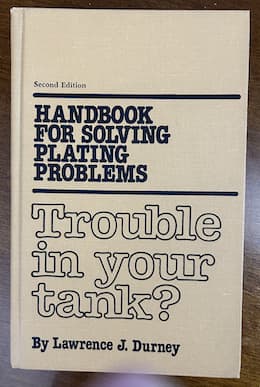
Curated with aloha by
Ted Mooney, P.E. RET

The authoritative public forum
for Metal Finishing 1989-2025

-----
Contamination limits for Woods Nickel Strike
A. I would like to know if anyone has established metal contaminant limits for a typical woods nickel activating bath?
John Tinderplating shop employee - Milwaukee, Wisconsin, USA
March 24, 2010
|
|
A. I will not comment on "metallic contaminants" but I will state that the statistically most frequent problem is that platers do not understand that leaving S-rounds soaking all weekend (when they should be using [and removing] Rolled Depolarized) increases the nickel metal content and changes the strike from an inefficient "strike" to an efficient plating solution that does not bond.  Robert H Probert Robert H Probert Technical Services Garner, North Carolina  March 25, 2010 Q. The main thing to watch in your Wood's bath is copper. You don't want more than 80 ppm or you will start to develop adhesion problems.  Jon Barrows, MSF, EHSSC Independence, Missouri March 25, 2010 |
Fe contamination in Woods Nickel
Q. We have been experiencing a low fail rate adhesion issue (blistering after 30 minute dwell at 300 °C) on S303 parts that are barrel plated through a Au/Ni process with Wood's strike. Our chemistry seems to be in spec with what everyone has recommended over the forum but we do have a significant level of Fe in the bath, at this point it is over 1000 ppm. Would codeposition of Fe in the Ni cause stress leading to adhesion problems? What are the standard levels of acceptability for Fe in Woods?
Thanks!
- Massachusetts, USA
November 15, 2018
November 2018
by Larry Durney

on Amazon
(currently UTL
on AbeBooks & eBay)
(affil links)
A. Hi Tim. I'm not aware of any textbook information on that subject, but 1000 ppm sounds like a huge amount of iron contamination even for standard nickel plating, let alone a Wood's nickel strike. I can't swear that iron contamination is the cause of your adhesion or stress problem, but I do note that in Durney's troubleshooting text "Trouble in Your Tank", right after "Don't Panic" and "Identify the Problem" is his third whole chapter entitled "Obey the Letter of the Law". 1000 ppm Fe is surely nowhere near right; don't talk yourself into accepting it :-)
It seems that there are two likely causes, operating with a partially anodic cycle (which is suggested in some text books, but which some knowledgable writers question), or parts falling off the rack and dissolving. Or is there another explanation for this high amount of iron?
Regards,

Ted Mooney, P.E. RET
Striving to live Aloha
finishing.com - Pine Beach, New Jersey
A. I do not think Fe contamination causes adhesion problems; iron causes roughness, maybe not enough Ni thickness, or current issue, or poor pre cleaning issue.

Popatbhai B. Patel
electroplating consultant - Roseville, Michigan
January 10, 2019
|
|
A. The most common cause of adhesion failure with a nickel chloride strike is the the anodes have been left in and the metal has climbed to where the inefficient strike has converted to an efficient plating solution. do not use S-rounds, use Rolled Depolarized solid nickel bars and take out when not in use.  Robert H Probert Robert H Probert Technical Services Garner, North Carolina  January 11, 2019 A. What I have found that causes most issues with adhesion in the woods nickel strike is copper contamination, not iron. However iron is the bane of most plating baths Thomas SwanEast Side Plating - Portland, Oregon, USA January 12, 2019 |
Q, A, or Comment on THIS thread -or- Start a NEW Thread